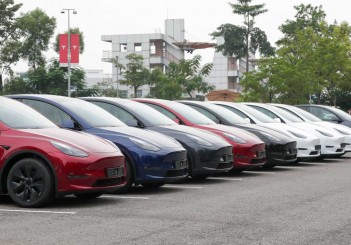Visitors at the first public opening day at the Beijing auto show today. — AFP
BEIJING: Sparkling on the inside like a jewellery box, it looms high over the masses of people. If there's one car that unites the current trends on the Chinese auto market into one striking design, then it’s the Vision Mercedes-Maybach Ultimate Luxury.
Because as an SUV with a notchback, this concept car shown at the Beijing Motor Show (April 29 to May 4) doesn’t just combine the most successful segments from the global auto industry. It also fulfils a growing need for luxury in a country that has more super-rich individuals than anywhere else in the world. Not a bad place for the auto industry to carve out a living.

Even if there are obviously many more people earning ordinary and especially low wages than millionaires, China has long since developed into the world’s most important car market, one with the biggest sales figures and the highest growth rates. Even the masses are yearning for luxury class vehicles, and manufacturers gladly deliver.
The best example here of catering to the Chinese driver is the extended versions of European saloons. This year’s Mercedes A-Class has become a notchback with 6 more centimetres of wheelbase just for China, so that it almost attains the format of the C-Class.
And it’s not only notchback models that are being stretched out on the rack. Audi has upped its first SUV, the Q5L, to XXL by making it 11 centimetres longer.
On top of that, Volkswagen (VW) has created a successor of its CC especially for China as well as the compact-class saloon Lavida, which is entering the next round as one of the most important models for the masses. And Ford is also selling the Focus here as a notchback.

The Kamiq. — dpa
And whatever isn’t a saloon has to be an SUV in China. The trend is so strong that a company like Skoda is developing a third off-road vehicle for the Chinese and underpinning its Karoq and Kodiaq fleet with the 4.39-meter long Kamiq.
VW has presented its new Touareg for the first time to a large audience. And Buick is getting people in the mood for a sporty and sleek interpretation of an SUV with its Enspire concept car. Even the BMW X6 looks pretty clumsy by comparison.
But there’s also a few new global innovations on top of all this special treatment being lavished on China. Lexus will unveil the fourth generation of its midsize-saloon ES, which will succeed the GS in Europa with its 218-horsepower hybrid drive.
BMW is lifting the curtain on its M2 Competition, with a six-cylinder engine being pushed to 410 horses. And according to Mercedes, the A-Class saloon will also be made available in Europe, but with the normal wheelbase of the five-door version.

The M2 Competition.
Still, China is not just the biggest driver for the luxury segment. Alternative motors count for even more here than pomp and circumstance. That’s because the government is literally promising its people the sky, giving their all in the transition to the electric motor in efforts to help clean up its smoggy cities. In the coming decade, China wants to see electric vehicles reach a 20-per-cent share of all vehicle sales.
And from 2019 onward, 10 per cent of every brand’s vehicle fleet will have to be sold as an electric. Manufacturers have already taken this into account in hurried obedience. No matter where you look, everywhere at this giant trade fair there are eco-friendlier cars.

That goes for China’s several dozen domestic manufacturers, above all for the more European-oriented brands Nio, Byton or Lynk & Co. But it also applies to the big importers.
VW for example has established a definitive electric-car brand called SOL especially for and in China and announced it would invest a total of 15 billion euro for 40 new models with alternative engines.
BMW is also putting its nearly production-ready concept of the iX3 on display (272 hp and a 400-kilometre range), marking the first time electrification will be implemented at the company’s core brand. Even the Maybach fits into this category, because as fat and unreasonable the SUV saloon may look, critics cannot find fault with its engine, driven by a total of 750 horses from four electric motors.
German manufacturers are still holding onto their spot as the industry’s most highly regarded brands with their cars in Beijing. But times are getting tougher, said one BMW manager with a view to the by now surprisingly serious cars made by China’s domestic manufacturers, nearly all of which are SUVs.
The designs are increasingly original and no longer copycat work, while the technology is solid and the drive normally electric. The days when Europe's manufacturers could laugh snobbishly at China's home players are long gone.










